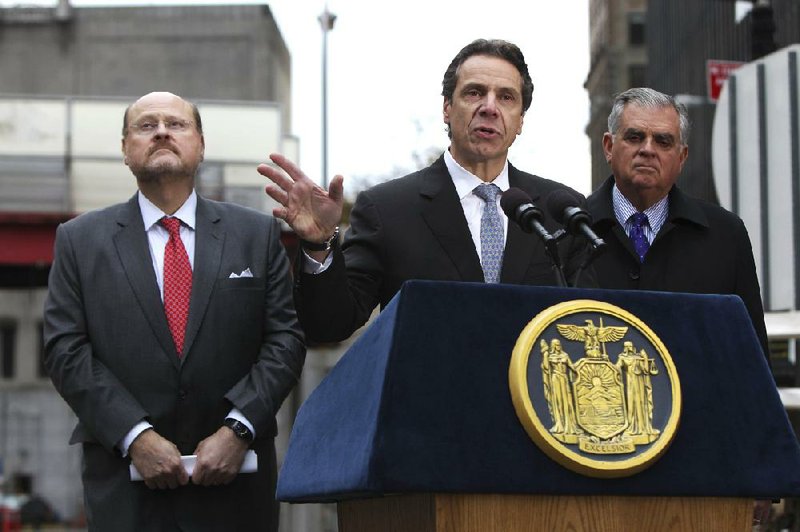ALBANY, N.Y. — Gov. Andrew Cuomo of New York, where 2 million customers lost power after superstorm Sandy, convened a commission to investigate utility companies for what he said was their failure to properly prepare.
The probe will look into how utilities responded to Sandy, which struck Oct. 29, and tropical storms Irene and Lee last year, according to a statement e-mailed Tuesday. The review will be conducted by a so-called Moreland Commission, which under a 105-year-old state law has the power to subpoena witnesses and documents, hold hearings and administer oaths.
“The silver lining of this storm is that the Legislature understands we have to overhaul the power-distribution system in this state,” Cuomo said at a briefing in Manhattan outside the Hugh L. Carey Tunnel, which reopened Tuesday. “I don’t think we have a choice. We can use the Moreland Commission with subpoena power to force the investigation, to force the study.”
Sandy knocked out power to more than 8.5 million customers in 21 states. As utilities struggled to get the lights back, they were criticized by Cuomo, New Jersey Gov. Chris Christie and thousands of customers, some of whom are still without power. Long Island Power Authority and National Grid, which operates its electricity network, were sued Tuesday by customers accusing them of failing to properly maintain and update an “outdated, obsolete” system.
The commission established Tuesday by Cuomo will review the overlapping responsibilities of what he called a “labyrinth” of regulatory bodies, agencies and utilities, including Long Island Power Authority, the Public Service Commission and the New York Power Authority. The goal is to determine what went wrong and how best to reshape the system, he said.
Cuomo, a Democrat, said those overlapping responsibilities have contributed to a dysfunctional system that brought down gasoline distribution and communication networks.
Consolidated Edison Inc., which serves New York City and suburban areas, has restored power to more than 1 million customers who lost it during Sandy and a nor’easter that struck Nov. 7. The restorations don’t include 16,300 in flood-ravaged areas of the city whose homes and businesses are too damaged, according to the company’s website.
“Con Edison looks forward to working with the commission to discuss the company’s preparation and response to Superstorm Sandy,” Chris Olert, a Con Edison spokesman, said in an e-mailed statement. “We will continue to work with all parties to review new technology and infrastructure options that would benefit New Yorkers.”
Cuomo has been faulted by lawmakers, including Sen. Carl Marcellino, for not exerting the power he wields over Long Island Power Authority, which provides power to about 1.1 million customers in Nassau, Suffolk and Queens counties through National Grid. After Sandy, about 90 percent of those customers lost power, and 52,000 were still in the dark Tuesday, according to the authority’s website.
The authority supports the statewide study, Mark Gross, a spokesman for the agency, said in an e-mailed statement.
In a June report requested by Cuomo, the Public Service Commission found that the authority fell short in its preparation and response to Tropical Storm Irene. The authority, which isn’t regulated by the state commission, didn’t provide accurate and timely power-restoration estimates, according to the report.
After Sandy, it was clear that the authority and National Grid were still struggling with communication, according to residents.
“It wasn’t just the fact the power was out,” said Ellen Schlank, a Plainview resident who still lacked electricity as of noon Tuesday. “It was a devastating storm; everyone understood that. It’s the lack of communication. We just want to know when the power will come back. That’s the worst part about it.”
Meanwhile, 13 senators from seven states damaged by Sandy are asking President Barack Obama to boost federal disaster aid to the states.
Senators from New York, New Jersey, Connecticut, Rhode Island, West Virginia, Delaware and Maryland asked Obama in a joint letter Tuesday to add more emergency aid for federal disaster-assistance programs in his 2013 budget request.
Over the past two weeks, the Federal Emergency Management Agency has spent about $1.5 billion mitigating the effects of Sandy. There’s about $6 billion left in FEMA’s disaster relief fund.
A new disaster aid funding plan was put in place by last year’s budget agreement in hopes of budgeting for disasters instead of having to pass emergency funding measures in the heat of the moment. The new mechanism permits the president to seek another $5.4 billion in disaster aid — on top of $7.1 billion approved as part of a six-month government funding bill — without breaking budget limits.
Information for this article was contributed by Freeman Klopott, Jim Polson, Jeran Wittenstein, Mark Chediak, Mike Lee, Martin Braun and Henry Goldman of Bloomberg News and by Andrew Miga and Andrew Taylor of The Associated Press.
Front Section, Pages 2 on 11/14/2012
